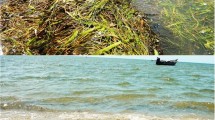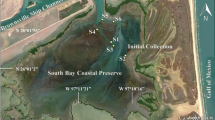Abstract
Seagrass ecosystems are globally-significant ‘blue carbon’ sinks; however, there is concern that this capacity will decline if rising ocean temperatures accelerate microbial decomposition. Decomposition of plant litter is a key process in the global carbon cycle—it influences how much carbon is available for sequestration. Therefore, understanding the biogeochemistry underlying decomposition is essential to predicting the capacity of seagrass ecosystems to act as carbon sinks in the future. Here, we tracked the breakdown of standardised and natural litter of varying chemical recalcitrance (rooibos tea > seagrass leaves > green tea) combined with highly-sensitive microsensor technology to test (a) how elevated water temperatures affect short-term microbial turnover, and (b) provide novel information on how the decay dynamics of the tea litter compare to those of natural litter. We found that increased temperatures (+ 5–10 °C) boosted microbial activity for all substrates, exhibited as enhanced decay, oxygen consumption and sulphate reduction. Within the 1-month experiment, the green tea litter had a rapid Q10 response to the temperature increase, quickly exhausting the resources for microbes, while the response of the rooibos tea and seagrass litters became more apparent toward the end of the experiment. Our results suggest that the tea litters capture a range of decomposition traits and can be compared with natural litter using traditional exponential decay models. The enhanced temperature-driven organic matter turnover, even under anoxic conditions, highlights the vulnerability of fresh litter to microbial attack during the early stages of decay and the potential weakening of blue carbon accumulation rates under future climatic conditions.







Similar content being viewed by others
Data availability
Upon acceptance, the data will be made available via Mendeley Data Repository.
References
Ainley L, Bishop M (2015) Relationships between estuarine modification and leaf litter decomposition vary with latitude. Estuar Coast Shelf Sci 164:244–252
Arnosti C, Jørgensen BB, Sagemann J, Thamdrup B (1998) Temperature dependence of microbial degradation of organic matter in marine sediments: polysaccharide hydrolysis, oxygen consumption, and sulfate reduction. Mar Ecol Prog Ser 165:59–70
Baird ME et al (2019) CSIRO environmental modelling suite (EMS): scientific description of the optical and biogeochemical models (vB3p0). Geosci Model Dev Discuss 13:4503–4553. https://doi.org/10.5194/gmd-2019-115
Berg B, McClaugherty C (2008) Decomposition as a process. In: Berg B, McClaugherty C (eds) Plant litter, 2nd edn. Springer, Berlin, pp 11–33. https://doi.org/10.1007/978-3-540-74923-3_2
Blum LK, Mills AL (1991) Microbial growth and activity during the initial stages of seagrass decomposition. Mar Ecol Prog Ser 70:73–82
Bourguès S, Auby I, De Wit R, Labourg PJ (1996) Differential anaerobic decomposition of seagrass (Zostera noltii) and macroalgal (Monostroma obscurum) biomass from Arcachon Bay (France). Hydrobiologia 329:121–131
Bradford MA et al (2017) A test of the hierarchical model of litter decomposition. Nat Ecol Evol 1:1836–1845
Brodersen KE, Koren K, Moßhammer M, Ralph PJ, Kühl M, Santner J (2017) Seagrass-mediated phosphorus and iron solubilization in tropical sediments. Environ Sci Technol 51:14155–14163
Brodersen KE, Siboni N, Nielsen DA, Pernice M, Ralph PJ, Seymour J, Kühl M (2018) Seagrass rhizosphere microenvironment alters plant-associated microbial community composition. Environ Microbiol 20:2854–2864
Brodersen KE, Trevathan-Tackett SM, Nielsen DA, Connolly RM, Lovelock C, Atwood TB, Macreadie PI (2019) Oxygen consumption and sulphate reduction in vegetated coastal habitats: effects of physical disturbance. Front Mar Sci 6:14
Burdige DJ (2007) Preservation of organic matter in marine sediments: controls, mechanisms, and an imbalance in sediment organic carbon budgets? Chem Rev 107:467–485
Burkholz C, Garcias-Bonet N, Duarte CM (2020) Warming enhances carbon dioxide and methane fluxes from Red Sea seagrass (Halophila stipulacea) sediments. Biogeosciences. https://doi.org/10.5194/bg-2019-93
Conover J, Green LA, Thornber CS (2016) Biomass decay rates and tissue nutrient loss in bloom and non-bloom-forming macroalgal species. Estuar Coast Shelf Sci 178:58–64
Cragg SM et al (2020) Vascular plants are globally significant contributors to marine carbon fluxes and sinks. Annu Rev Mar Sci 12:469–497
Cúcio C, Engelen AH, Costa R, Muyzer G (2016) Rhizosphere microbiomes of European seagrasses are selected by the plant, but are not species specific. Front Microbiol 7:440
Davidson EA, Janssens IA (2006) Temperature sensitivity of soil carbon decomposition and feedbacks to climate change. Nature 440:165–173
Dawes CJ, Guiry MD (1992) Proximate constituents in the seagrasses Zostera marina and Z. noltii in Ireland: seasonal changes and the effect of blade removal. Mar Ecol 13:307–315
Didion M, Repo A, Liski J, Forsius M, Bierbaumer M, Djukic I (2016) Towards harmonizing leaf litter decomposition studies using standard tea bags—a field study and model application. Forests 7:167
Djukic I et al (2018) Early stage litter decomposition across biomes. Sci Total Environ 628:1369–1394
Duddigan S, Shaw LJ, Alexander PD, Collins CD (2020) Chemical underpinning of the tea bag index: an examination of the decomposition of tea leaves. Appl Environ Soil Sci. https://doi.org/10.1155/2020/6085180
Godshalk GL, Wetzel RG (1978) Decomposition of aquatic angiosperms. III. Zostera marina L. and a conceptual model of decomposition. Aquat Bot 5:329–354
Harrison PG (1989) Detrital processing in seagrass systems: a review of factors affecting decay rates, remineralization and detritivory. Aquat Bot 35:263–288
Jedrzejczak MF (2002) Stranded Zostera marina L. vs wrack fauna community interactions on a Baltic sandy beach (Hel, Poland): a short-term pilot study. Part II. Driftline effects of succession changes and colonisation of beach fauna. Oceanologia 44:367–387
Jensen SI, Kühl M, Priemé A (2007) Different bacterial communities associated with the roots and bulk sediment of the seagrass Zostera marina. FEMS Microbiol Ecol 62:108–117
Jørgensen BB, Revsbech NP (1985) Diffusive boundary layers and the oxygen uptake of sediments and detritus. Limnol Oceanogr 30:111–122
Keuskamp JA, Dingemans BJ, Lehtinen T, Sarneel JM, Hefting MM (2013) Tea Bag Index: a novel approach to collect uniform decomposition data across ecosystems. Methods Ecol Evol 4:1070–1075
Klap VA, Hemminga MA, Boon JJ (2000) Retention of lignin in seagrasses: angiosperms that returned to the sea. Mar Ecol Prog Ser 194:1–11. https://doi.org/10.3354/meps194001
Kristensen E (2000) Organic matter diagenesis at the oxic/anoxic interface in coastal marine sediments, with emphasis on the role of burrowing animals. Hydrobiologia 426:1–24
Laffoley DdA, Grimsditch G (2009) The management of natural coastal carbon sinks. Gland, Switzerland
Macreadie PI, Hardy SS (2018) Response of seagrass ‘blue carbon’stocks to increased water temperatures. Diversity 10:115
Macreadie PI, Baird ME, Trevathan-Tackett SM, Larkum AWD, Ralph PJ (2014) Quantifying and modelling the carbon sequestration capacity of seagrass meadows – a critical assessment. Mar Pollut Bull 84:430–439
Macreadie PI et al (2017) Can we manage coastal ecosystems to sequester more blue carbon? Front Ecol Environ 15:206–213
Macreadie P, Atwood T, Seymour J, Fontes MS, Sanderman J, Nielsen D, Connolly R (2019) Vulnerability of seagrass blue carbon to microbial attack following exposure to warming and oxygen. Sci Total Environ 686:264–275
Macreadie PI et al (2019) The future of Blue Carbon science. Nat Commun 10:1–13
Marley AR, Smeaton C, Austin WE (2019) An assessment of the tea bag index method as a proxy for organic matter decomposition in intertidal environments. J Geophys Res 124:2991–3004
Mateo M, Cebrián J, Dunton K, Mutchler T (2006) Carbon flux in seagrass ecosystems. Seagrasses: biology, & ecology and conservation. Springer, Netherlands, pp 159–192
Mueller P et al (2018) Global-change effects on early-stage decomposition processes in tidal wetlands–implications from a global survey using standardized litter. Biogeosciences 15:3189–3202
Nicastro A, Onoda Y, Bishop MJ (2012) Direct and indirect effects of tidal elevation on eelgrass decomposition. Mar Ecol Prog Ser 456:53–62. https://doi.org/10.3354/meps09635
Ochieng CA, Erftemeijer PL (1999) Accumulation of seagrass beach cast along the Kenyan coast: a quantitative assessment. Aquat Bot 65:221–238
Pedersen AGU, Berntsen J, Lomstein BA (1999) The effect of eelgrass decomposition on sediment carbon and nitrogen cycling: a controlled laboratory experiment. Limnol Oceanogr 44:1978–1992
Pedersen MO, Serrano O, Mateo MA, Holmer M (2011) Temperature effects on decomposition of a Posidonia oceanica mat. Aquat Microb Ecol 65:169–182. https://doi.org/10.3354/ame01543
Pellikaan GC (1982) Decomposition processes of eelgrass, Zostera marina L. Hydrobiol Bull 16:83–92
Petraglia A et al (2019) Litter decomposition: effects of temperature driven by soil moisture and vegetation type. Plant soil 435:187–200
Preisler A, De Beer D, Lichtschlag A, Lavik G, Boetius A, Jørgensen BB (2007) Biological and chemical sulfide oxidation in a Beggiatoa inhabited marine sediment. ISME J 1:341–353
Robson BJ et al (2018) Towards evidence-based parameter values and priors for aquatic ecosystem modelling. Environ Model Softw 100:74–81
Sarneel JJ, Veen GC (2017) Legacy effects of altered flooding regimes on decomposition in a boreal floodplain. Plant Soil 421:57–66
Scully NM, Maie N, Dailey SK, Boyer JN, Jones RD, Jaffé R (2004) Early diagenesis of plant-derived dissolved organic matter along a wetland, mangrove, estuary ecotone. Limnol Oceanogr 49:1667–1678
Seelen LM et al (2019) An affordable and reliable assessment of aquatic decomposition: tailoring the Tea Bag Index to surface waters. Water Res 151:31–43
Sinsabaugh R, Carreiro M, Alvarez S (2002) Enzyme and microbial dynamics of litter decomposition. In: Burns RG, Dick RP (eds) Enzymes in the environment: activity, ecology and application. books in soils, plants, and the environment. Marcel Dekker, Inc., New York. https://doi.org/10.1201/9780203904039.ch9
Spivak AC, Sanderman J, Bowen JL, Canuel EA, Hopkinson CS (2019) Global-change controls on soil-carbon accumulation and loss in coastal vegetated ecosystems. Nat Geosci 12:685–692
Thomson AC, Trevathan-Tackett SM, Maher DT, Ralph PJ, Macreadie PI (2019) Bioturbator‐stimulated loss of seagrass sediment carbon stocks. Limnol Oceanogr 64:342–356
Trevathan-Tackett SM, Kelleway JJ, Macreadie PI, Beardall J, Ralph P, Bellgrove A (2015) Comparison of marine macrophytes for their contributions to blue carbon sequestration. Ecology 96:3043–3057. https://doi.org/10.1890/15-0149.1
Trevathan-Tackett SM, Macreadie PI, Sanderman J, Baldock J, Howes J, Ralph P (2017a) A global assessment of the chemical recalcitrance of seagrass tissues: implications for long-term carbon sequestration. Front Plant Sci 8:925. https://doi.org/10.3389/fpls.2017.00925
Trevathan-Tackett SM et al (2017b) Sediment anoxia limits microbial-driven seagrass carbon remineralization under warming conditions. FEMS Microbiol Ecol 93:6. https://doi.org/10.1093/femsec/fix033
Trevathan-Tackett SM, Jeffries TC, Macreadie PI, Manojlovic B, Ralph P (2020) Long-term decomposition captures key steps in microbial breakdown of seagrass litter. Sci Total Environ 705:135806
Wieder RK, Lang GE (1982) A critique of the analytical methods used in examining decomposition data obtained from litter bags. Ecology 63:1636–1642
Acknowledgements
Thank you to the volunteers who put in the long hours helping in this project, particularly Grace Waddingham and Pawel Waryszak. The tea litter was provide by Unilever Lipton via the TeaComposition and TeaComposition H2O initiatives.
Funding
The research was supported by grants from the Alfred Deakin Postdoctoral Research Fellowship (STT), the Carlsberg Foundation (CF16-0899; KEB), and an Australian Research Council Discovery Grant DP200100575 (PM).
Author information
Authors and Affiliations
Contributions
STT, KEB and PM designed the research. STT and KEB performed the experiments. STT processed and analysed the data with inputs from KEB. All authors contributed with manuscript writing and gave final approval for publication.
Corresponding author
Ethics declarations
Conflict of interest
There are no conflicts of interest or competing interests.
Additional information
Responsible Editor: Scott Bridgham
Publisher’s Note
Springer Nature remains neutral with regard to jurisdictional claims in published maps and institutional affiliations.
Electronic supplementary material
Below is the link to the electronic supplementary material.
Rights and permissions
About this article
Cite this article
Trevathan-Tackett, S.M., Brodersen, K.E. & Macreadie, P.I. Effects of elevated temperature on microbial breakdown of seagrass leaf and tea litter biomass. Biogeochemistry 151, 171–185 (2020). https://doi.org/10.1007/s10533-020-00715-1
Received:
Revised:
Accepted:
Published:
Issue Date:
DOI: https://doi.org/10.1007/s10533-020-00715-1




